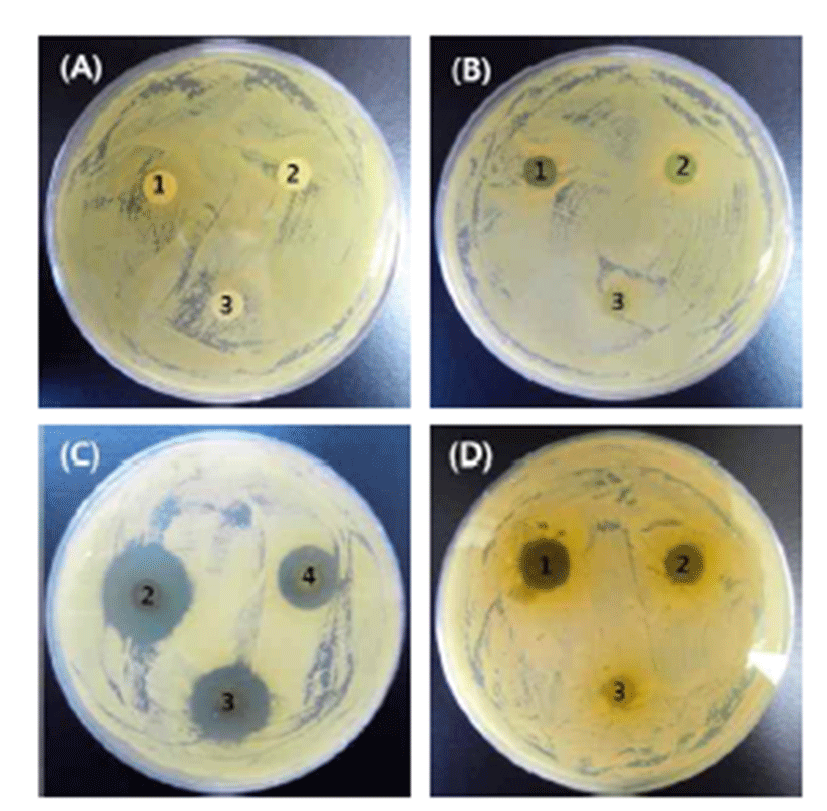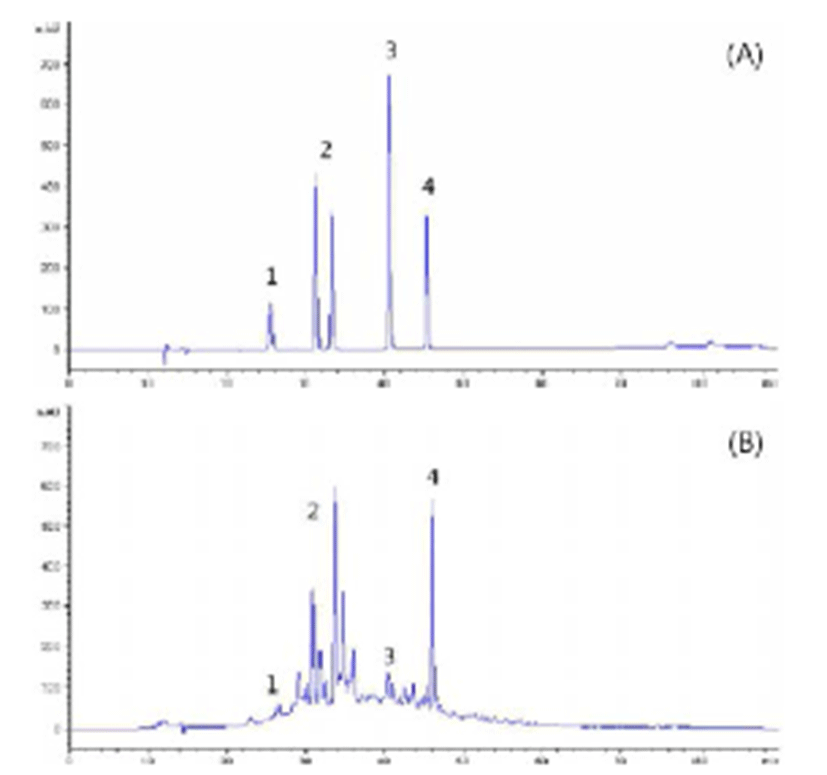서 론
식품의 부패와 변질을 방지하고 선도를 유지할 목적으로 오래전부터 소르빈산류, 안식향산류, 프로피온산류 등의 많은 화학 합성보존료가 개발되어 이용되고 있다. 현재 우 리나라 식품위생법에는 총 22종의 화학합성보존료의 사용 이 허가되어 있으나, 이들 보존료 중 일부의 지속적인 사용 은 돌연변이나 기형 유발 등 안전성에 문제를 일으킬 우려 가 있다(1). 최근 식품 안전성에 대한 관심과 건강에 대한 욕구가 증가함에 따라 화학 합성보존료에 대한 소비자들의 기피현상이 증대되므로 천연물 중의 phytochemicals을 이 용한 식품 보존료 개발의 필요성이 대두되고 있다.
오죽(烏竹, Phyllostachys nigra MUNRO)은 대나무의 한 종류로 주로 강원도 등지에서 많이 자생하고 있으며, 첫해 는 줄기의 색이 초록색이지만 2년째부터 검은 자색이 짙어 져 검은색으로 변한다(2). 현재 건축신소재, 수공예품, 기능 성 식품의 원료로 사용 되거나 잎을 덖어 차로 음용, 중국에 서 소염작용과 관련하여 전통적인 의약품으로 사용되고 있다(2-4). 동의보감, 본초강목, 신농본초경에 의하면 중풍, 고혈압을 치료하는데 탁월한 효과가 있으며, 잎은 해열, 거담, 청량 등의 목적으로 폐렴이나 기관지염 등의 치료에 사용되었다고 기록되어 있다(5). 또한 대나무 잎의 페놀 화합물은 항산화작용, 항미생물작용, 항암작용 등과 같은 생물학적 효과가 있다(2,5,6). 오죽의 이용에 관하여는 잎차 와 죽순 차의 성분 분석(2), flavone 성분의 추출 및 항산화활 성 분석(3), 잎 성분의 가압 액체추출의 최적화(4), 줄기와 잎의 에탄올 추출물의 생리활성(5), 잎 성분의 망막 신경절 보호제 연구(7) 등이 있다.
본 연구에서는 오죽 잎을 기능성 소재로서 이용하기 위 하여 극성에 따른 용매분획물을 제조하고 이들의 항산화 활성과 항산화 성분을 비롯하여 주요 식중독세균인 Staphylococcus aureus에 대한 항균 활성을 조사하고 활성 성분을 HPLC로 분석하였다.
재료 및 방법
실험에 사용한 오죽(Phyllostachys nigra MUNRO) 잎은 2012년 8월 경에 경북대학교 내에서 채취하여 음건(25℃, 24시간)하고 분쇄하여(25~40 mesh)사용하였다. 실험에서 사용한gallic acid, trolox, naringin, 1,1-diphenyl-1-picrylhydrazyl (DPPH), 2,4,6-tris(2-pyridyl)-1,3,5-triazine(TPTZ)는 Sigma 사(Sigma Chemical Co., St, Louis, MO, USA)의 제품을 사용 하였다. 추출용매 및 분석용 시약은 분석용 특급시약 (Duksan Co., Seoul, Korea)을 사용하였다. HPLC 용매는 J. T. Baker(Phillpsbug, NJ, USA) 제품, tryptic soy broth (TSB)는 Difco사(Detroit, MI, USA)의 제품을 사용하였다.
분쇄한 오죽 잎 15 g에 10배량의 methanol을 가한 후 12시간 동안 2회 추출하여 여과하고 감압 농축하여 조추출 물 1.20 g을 얻고, 이를 다시 10% methanol에 현탁하여 극성 에 따라 순차적으로 용매 분획하여 n-hexane 분획물(0.32 g), ethyl acetate 분획물(0.24 g), n-butanol(0.12 g), 물 분획물 (0.51 g)을 얻었다.
오죽추출물의 항산화 효과는 Blois(7)의 방법으로 측정 하였다. 시료(5 mg/mL) 100 μL에 300 μM DPPH 용액 900 μL를 가하여 잘 섞고, 30분간 암실에서 방치한 다음 517 nm에서 흡광도를 측정한 후 표준물질인 gallic acid 검량선 의 회귀식에서 gallic acid equivalent μM(GAE μM)로 환산하 여 나타내었다.
FRAP 활성은 시료 중의 항산화 물질에 의해 Fe (Ⅲ)-TPTZ가 Fe(Ⅱ)-TPTZ 혼합물로 환원되는 원리에 의한 Benzie등의 방법(8)을 응용하여 측정하였다. Acetate buffer (300 mM, pH 3.6)와 10 mM TPTZ solution, 20 mM의 ferric chloride solution(FeCl3·6H2O)를 10:1:1 비율로 혼합하여 3 7℃에서 10분간 방치하여 반응 시액(cocktail solution)을 만 들었다. 시료(5.0 mg/mL) 250 μL와 cocktail solution 1.75 mL을 혼합하여 암실에서 30분간 방치한 후 590 nm에서 흡광도를 측정하여 trolox의 검량선의 회귀식에서 trolox equivalent μM(TE μM)로 나타내었다.
총페놀성 화합물 함량은 Folin-Ciocalteu regent 시약을 이용하여 측정하였다(9). 시료(5.0 mg/mL) 100 μL에 2 N Folin-Ciocalteau 시약 50 μL와 20% Na2CO3 300 μL를 가하 여 실온에서 15분간 방치한 후 증류수 1 mL을 넣고 원심분 리한 후 상등액을 725 nm에서 흡광도를 측정하였다. 표준 물질로 gallic acid 검량선의 회귀식에서 시료 중의 총페놀화 합물의 함량을 GAE μM로 환산하였다.
총플라보노이드 화합물 함량 측정은 Jia 등(10)의 방법으 로 측정하였다. 시료(5.0 mg/mL) 70 μL에 50% ethanol 430 μL를 가한 후 5% NaNO2 50 μL를 넣고 혼합하여 1시간 동안 방치한 후 10% Al(NO3)3·9H2O 50 μL를 넣고 6분간 반응시켰다. 1 N NaOH 500 μL를 넣고 510 nm에서 흡광도 를 측정하였으며 naringin의 검량선의 회귀식에서 naringin equivalent μM(NAE μM)로 환산하여 나타내었다.
오죽 잎의Staphylococcus aureus(ATCC 6538)에 대한 항 균 활성은 agar diffusion method를 이용하여 측정하였다 (11,12). S. aureus를 tryptic soy broth(TSB)(Difco Co.)에 3 7℃ incubator에서 24시간 정치배양하여 흡광도 0.3으로 TSB를 이용하여 조절한 후 agar를 첨가한 TSB 배지에 200 μL씩 접종하고 도말하였다. 그리고 멸균된 paper disc(Toyo Roshi 27, Ø 8 mm)에 시료를 농도별(2.5, 5, 10, 20 mg/mL)로 흡수시키고 건조하여 배지 위에 밀착시킨 후 37℃에서 18∼ 24시간 배양하였다. Paper disc 주위의 저해환(clear zone)의 직경(mm)은 캘리퍼스(Dial calipers, Alltrade, USA)를 이용 하여 측정하였다.
오죽 잎의 ethyl acetate fraction을 methanol에 녹여 4 mg/mL로 한 뒤, 0.45 μm filter로 여과하여 HPLC(1260 Infinity Quaternary LC System, Agilent Technologies, Waldbronn, Germany)와 ZORBAX Eclipse Plus C18 column (4.6 mm×150 mm, 5 μm, Agilent technologies, USA)을 사용 하여, injection volume은 10 μL, 이동상은 용매 A(2% acetic acid in 30% methanol)와 B(2% acetic acid in acetonitrile)를 유속 0.2 mL/min 으로 A액과 B액의 비율이 0분에 100:0 (v/v)에서 70분까지 0:100(v/v), 90분까지 100:0(v/v)인 농도 기울기법을 이용하여 PDA detector 280 nm로 분석하였다. 함량 측정은 caffeic acid, ferulic acid, quercetin, kaempferol 을 표준물질로 사용하여 검량곡선을 작성하여 구하였다.
결과 및 고찰
DPPH는 화합물 내 질소 중심의 radical로 radical 전자의 비편재화에 의해 안정한 구조의 radical로 존재하는데 radical이 항산화 물질과 반응하게 되면 본래의 자색에서 무색으로 변하게 된다(13). 오죽 잎 용매분획물들의 항산화 활성을 DPPH 라디칼 소거 활성법과 FRAP 활성법으로 측 정한 결과를 Table 1에 나타내었다. DPPH 라디칼 소거 활성 법에 의한 항산화 활성은 ethyl acetate, n-butanol, n-hexane, 물 분획물의 순으로 낮게 나타났다. 특히 오죽 잎의 ethyl acetate 분획물과 n-butanol 분획물의 활성은 각각, 430.43±10.14 GAE μM, 314.75±17.14 GAE μM로 다른 분획 물에 비하여 현저하게 높은 활성을 보였다. 산화 및 환원 반응에 의한 FRAP 활성도 역시 ethyl acetate 분획물이 202.33±10.25 TE μM 정도로 가장 높게 나타났으며 그 다음 으로는 n-hexane, n-butanol, 물분획물의 순이었다. DPPH 활성과는 다르게 n-hexane 분획물이 n-butanol 분획물 보다 활성이 높은 것은 비극성의 환원성 물질들이 n-butanol 분획 물 보다 n-hexane 추출물 중에 많이 함유되어 작용한 것으로 서, 겨우살이 추출물의 ethyl ether 분획물에서 항산화 활성 이 가장 강하였다는 보고(14)와 유사하였다.
| Fraction | DPPH (µM GAE) | FRAP (µM TE) |
|---|---|---|
| A1) | 57.88±11.22d2) | 72.07±3.75d |
| B | 314.75±17.14b | 103.11±2.34c |
| E | 430.43±10.14a | 202.33±10.25a |
| H | 97.88±22.35c | 128.00±9.26b |
식물 성분 중의 페놀성 화합물은 산소 라디칼을 제거하 거나 산화환원 반응을 촉매하는 금속이온을 환원하여 생체 내에서 항산화작용을 수행한다. 또한 페놀성 화합물의 수 산기는 단백질과 같은 거대분자들과 결합하는 성질이 있어 미생물의 성장과 효소 활성을 저해한다(14,15). 식물 성분 중의 페놀성 화합물의 총량은 산화 환원 반응에 의하여 총페놀성 화합물을 정량하는 Folin-Denis 방법(16)을 변용 한 비교적 간단한 Folin-Ciocalteau 시약에 의한 방법(9)으로 많이 측정하고 있다.
오죽 잎 용매분획물들의 총페놀성 및 총플라보노이드 화합물의 함량을 측정한 결과를 Table 2에 나타내었다. 오 죽 잎 용매분획물들의 총페놀성 화합물 함량은 ethyl acetate 분획물이 1.93±0.14 GAE mM로 가장 높았으며, n-butanol, n-hexane, 그리고 물 분획물의 순이었다. 총플라보노이드 화합물의 함량은 n-hexane 분획물이 가장 높았으며, ethyl acetate, n-butanol, 물 분획물의 순이었다. 전체적으로 보아 서, 항산화 활성이 큰 ethyl acetate 분획물에서 총페놀성 화합물의 함량이 현저하게 높았으며, 이는 식물의 총페놀 성 화합물과 항산화 활성은 상관성이 큰 것으로 알려져 있는 보고(17,18)와 유사한 결과를 나타내었다.
| Fraction | DPPH (µM GAE) | FRAP (µM TE) |
|---|---|---|
| A1) | 0.68±0.09d2) | 7.20±0.64d |
| B | 1.32±0.12b | 20.00±1.17c |
| E | 1.93±0.14a | 38.83±0.73b |
| H | 1.19±0.07b | 62.31±3.07a |
오죽 잎 용매분획물들의 항균활성을 agar diffusion 방법 으로S. aureus에 대하여 측정한 결과를 Table 3과 Fig. 1에 나타내었다. 20 mg/disc 농도에서 물 분획물과 n-hexane 분 획물은 항균활성을 나타내지 않은 반면, 10 mg/disc 농도에 서는 ethyl acetate 분획물의 clear zone이 22.6±0.89 mm로 가장 높게 나타났고, 그 다음으로 n-butanol 분획물이 11.2±0.45 mm로 높았다. Moon 등(19)은 약용식물의 ethyl acetate 분획물이 Bacillus cereus, Bacillus subilis, Staphylococcus aureus, Staphylococcus epidermidis와 같은 그람 양성균에 강한 항균력을 보인다고 보고한 바가 있다. Clark 등(20)은 식물류 중의 페놀성 화합물들이 항균작용을 나타낸다고 보고하였으며, 페놀성 화합물의 함량이 높을수 록 항산화 및 항균 활성이 높게 나타났다(21)는 보고가 있 다. 따라서 ethyl acetate 분획물이 S. aureus에 대한 증식 억제 활성이 높게 나타난 것은 획분 중에 풍부한 총페놀성 화합물이 활성인자로 작용하는 것으로 판단되었다.
| Fraction | Clear zone (mm) | |||
|---|---|---|---|---|
| 20 mg/disc | 10 mg/disc | 5 mg/disc | 2.5 mg/disc | |
| A1) | -2) | - | - | - |
| B | 12.6±0.553) | 11.2±0.45b | - | - |
| E | - | 22.6±0.89a | 18.6±0.55 | 15.2±0.45 |
| H | - | - | - | - |

오죽 잎 용매분획물들의 항산화 활성과 총페놀성 및 총 플라보노이드 화합물의 함량을 조사한 결과, ethyl acetate 분획물의 활성과 함량이 가장 높았으며 또한 S. aureus에 대한 항균활성도 가장 강하였다. 따라서 ethyl acetate 분획 물 중의 활성 성분을 HPLC를 이용하여 조사하고 크로마토 그램(Fig. 2)과 각 성분들의 함량을 분석하였다(Table 4).
| Compound | Contents (ppm) |
|---|---|
| caffeic acid | 10.95±0.68d1) |
| ferulic acid | 13.54±0.57c |
| quercetin | 16.01±0.05b |
| kaempferol | 61.31±1.89a |

오죽 잎의 ethyl acetate 분획물 중에서 caffeic acid, ferulic acid와 같은 phenyl propanoid 형의 페놀산과 quercetin, kaempferol과 같은 flavonol 화합물이 분리되었다. 이 중 kaempferol (61.31±1.89 ppm)이 가장 높은 함량을 나타냈으 며, quercetin (16.01±0.05 ppm), ferulic acid (13.54±0.57 ppm), caffeic acid (10.95±0.68 ppm)의 순서로 함량이 낮았 다.
요 약
오죽 잎의 메탄올 조추출물을 극성에 따라 용매분획하고 분획물의 항산화 활성과 항산화 활성, S. aureus 균주에 대 한 항균활성을 조사하고 활성성분을 HPLC를 이용하여 정 량하였다. 용매분획물 중에서 ethyl acetate 분획물의 DPPH radical 소거 활성, FRAP활성이 모두 가장 강하였으며, 총페 놀성 화합물의 함량도 가장 높았다. S. aureus 균주에 대한 항균활성 역시 ethyl acetate 분획물이 모든 시험 농도에서 가장 높은 활성을 보였다. Ethyl acetate 분획물 중에서 caffeic acid, ferulic acid, quercetin, kaempferol 성분을 분리 하여 정량하였으며 이 중 kaempferol의 함량이 가장 높았다. 오죽 잎의 ethyl acetate 분획물은 천연 식품보존료로서 활용 이 가능할 것으로 보인다.










